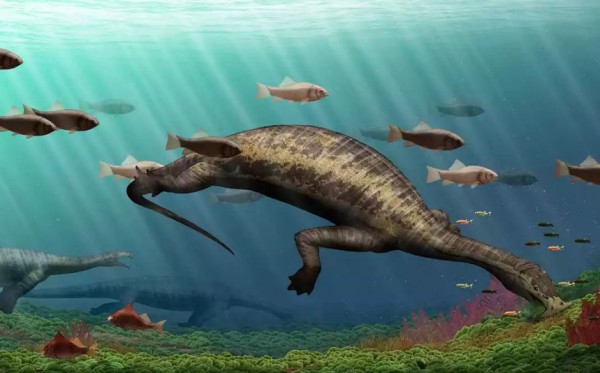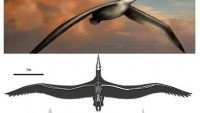Prehistoric Marine Reptile with Hammerhead Mouth was First Vegetarian Animal
| Arthur Dominic Villasanta | | May 07, 2016 04:32 AM EDT |
(Photo : Y. Chen, Institute of Vertebrate Palaeontology and Palaeoanthropology) Atopodentatus unicus feeding
A bizarre, prehistoric sea-dwelling reptile with a weird hammerhead mouth has been identified by archaeologists as the first herbivorous or plant eating marine reptile.
Atopodentatus unicus that thrived 243 million years ago after the Permian-Triassic extinction event (also known as the Great Dying) in China's Yunnan Province used its jaw scoop-up algae and underwater plants much like a baleen whale ingests massive numbers of krill. Scientists called the creature the first vegetarian marine reptile ever discovered.
Like Us on Facebook
"We were blown away by this," said Nick Fraser, a paleontologist at the National Museum of Scotland. "There were some strange animals around (back then), and this reminds me of one of those Dr. Seuss creations in Oh, the Thinks You Can Think!"
Scientists came to the conclusion the fossil was a herbivore by closely analyzing a small skull fragment just 11.4 centimeters wide. Their analysis showed the front of the wide mouth was lined with a bunch of big, sharp teeth.
Atopodentatus unicus (Latin for "unique peculiar teeth") had a slender body measuring some three meters long. It was propelled underwater by a pair of flippers and seems to have had a short neck. The reptile's imposing mouth lined with hundreds of densely packed, needlelike teeth drew most of the scientist's attention, however.
Scientists believe Atopodentatus unicus used its huge mouth and needle teeth to pry algae from the ocean floor. The animal then vacuumed-in algae-laden water and filtered the water out through its densely packed teeth, leaving the algae and other marine plants inside its mouth.
Fraser said it was very difficult looking at the fossil itself to see how the creature's vacuum cleaner-type mouth worked.
"So we bought some clay and toothpicks and arranged them in this jaw and saw what was going on."
Their study was published in Science Advances.
TagsAtopodentatus unicus, National Museum of Scotland, Nick Fraser, science advances
©2015 Chinatopix All rights reserved. Do not reproduce without permission
EDITOR'S PICKS
-

Did the Trump administration just announce plans for a trade war with ‘hostile’ China and Russia?
-

US Senate passes Taiwan travel bill slammed by China
-

As Yan Sihong’s family grieves, here are other Chinese students who went missing abroad. Some have never been found
-

Beijing blasts Western critics who ‘smear China’ with the term sharp power
-

China Envoy Seeks to Defuse Tensions With U.S. as a Trade War Brews
-

Singapore's Deputy PM Provides Bitcoin Vote of Confidence Amid China's Blanket Bans
-

China warns investors over risks in overseas virtual currency trading
-

Chinese government most trustworthy: survey
-

Kashima Antlers On Course For Back-To-Back Titles
MOST POPULAR
LATEST NEWS
Zhou Yongkang: China's Former Security Chief Sentenced to Life in Prison

China's former Chief of the Ministry of Public Security, Zhou Yongkang, has been given a life sentence after he was found guilty of abusing his office, bribery and deliberately ... Full Article
TRENDING STORY

China Pork Prices Expected to Stabilize As The Supplies Recover

Elephone P9000 Smartphone is now on Sale on Amazon India

There's a Big Chance Cliffhangers Won't Still Be Resolved When Grey's Anatomy Season 13 Returns

Supreme Court Ruled on Samsung vs Apple Dispute for Patent Infringement

Microsoft Surface Pro 5 Rumors and Release Date: What is the Latest?












